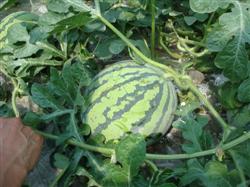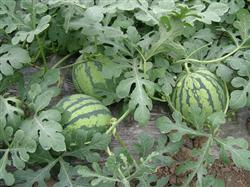Key points of high-yield cultivation techniques of watermelon in open field in spring

At present, it is the season of sowing and breeding of watermelon in open field. in order to do a good job in watermelon planting and improve farmers' income, the main points of cultivation techniques of open field watermelon in spring are introduced as follows: first, varieties should be selected according to market demand. Select varieties with good quality, high yield and strong disease resistance, such as Qinghongbao, Heifeng Bawang, Jingfengbao and so on. Second, the choice of planting land to plant watermelon plots to choose leeward and sunny flat land, not continuous cropping, it is appropriate to choose plots with convenient drainage and irrigation, deep soil layer and rich organic matter. After the soil is turned deep and dried for half a month, the soil is broken and the whole border is made into a 2.5-meter trench with a height of 40 cm on one side and 20 cm on the other. Dig a planting ditch with a depth of 25 cm and a width of 40 cm on one side of the high border, and apply 1000-1500 kg of rotten farm manure, 25 kg of ternary compound fertilizer, 1.5-2 kg of borax and 4 kg of magnesium sulfate per mu. When applying in the ditch, the fertilizer and backfilled soil should be mixed evenly. Soak the watermelon seeds with full seeds in 55 ℃ warm water and stir them continuously. When the water temperature drops to 30 ℃, soak for another 5 hours, wash the mucus on the seed coat, drain the water and sow the seeds in time. 4. Sowing watermelons covered with plastic film in early spring should be sown in late April. The sowing method should be sowed in the middle of plastic film, with 3 grains per hole, sowing depth 2 cm, and covering with fine soil after sowing. Fifth, seedling management and seedling density after emergence, pay attention to timely release of seedlings, in order to prevent seedlings from roasting to death. Watermelon seedlings can be planted with 3-4 leaves. The planting density per mu of large watermelon is 600-700 watermelon and that of small watermelon is 700-800 watermelon. 6. Field management. Fertilizer and water management. Pay attention to careful application of seedling fertilizer, skillful application of vine fertilizer, and re-application of expanded melon fertilizer. Seedling lifting fertilizer is carried out 5-7 days after planting, and generally 0.3% solution is applied with urea and compound fertilizer at the ratio of 1:2. Vine extension fertilizer is generally used about 20 days after seedling lifting, with 15 grams of urea and 15 grams of potash fertilizer per plant. 25 cm deep ditches were opened on both sides 35 cm outside the planting point, and the fertilizer was applied to cover the soil in the ditch. The melon fertilizer was carried out when the young fruit was the size of eggs, and each plant was treated with urea 30g 40g, calcium superphosphate 15g, potash fertilizer 30g 40g. At 50 cm outside the planting point, the application method was the same as that of vine fertilizer, but the position of the ditch should be perpendicular to the extended vine fertilizer ditch. Spring watermelons must be drained in time after rain, so that the rain stops the ditch to dry. In case of high temperature and drought during the melon sitting period, furrow irrigation can be adopted at night, but the border must be kept slightly dry, that is, drainage. two。 Ploughing and weeding. Intertillage weeding should be carried out when the watermelon vine is 40cm to 50cm long. if the vine is too long and ploughing, it is not only inconvenient to operate, but also easy to damage vine leaves and cause disease and invade, and hoe loose soil, which is easy to splash leaves, flowers and young melons after rain. 3. Prune and trim the vine. The common pruning methods are double-vine type and three-vine type. The double vine style is to retain the main vine and a strong side vine at the base of the main vine, and remove the rest of the side vine as early as possible. This method is suitable for close planting, has a high setting rate, and is widely used in early-maturing cultivation or in plots with relatively poor soil. The three-vine style retains the main vine and selects 2 strong side vines on the third to fifth nodes of the base of the main vine to remove the other side vines. In this way, mid-and late-maturing varieties are widely used. From the emergence of the main vine to the opening of the first female flower, the melon seedlings are arranged every 3-4 days, so that the main vine extends forward regularly. After flowering, no vine management is carried out. 4. Artificial pollination. Spring watermelons are prone to continuous overcast and rainy weather, which affects insect activities. Artificial pollination can be adopted to increase the rate of melon setting. 5. Promote melon sitting. It is ideal to leave the second and third female flowers on the main vine. The fruit of the female flower far away from the main root is also small, which is generally not suitable to stay. 6. Fruit management. In the process of multi-vine pruning and laissez-faire cultivation, sometimes several melons or sitting melon nodes on a plant are not ideal, so measures should be taken to remove young melons with low node position or abnormal shape and injured with disease, so as to retain and ensure the development of normal fruit at normal node position. 7. Comprehensive control measures should be taken for the control of watermelon diseases and insect pests. 1. Agricultural prevention and control. One is to clean up the weeds on the roadside near the melon field to reduce the hosts available in the early stage of pests; the other is to pay attention to the removal of diseased plants of watermelons, which should be removed, concentrated, buried or burned, and should not be casually thrown in the ditch or by the roadside. two。 Chemical control. To prevent and cure Fusarium wilt, 50% carbendazim wettable powder or 1000 times methyl topiramate can be used to irrigate the root once, 250ml per hole. Virus diseases are mainly transmitted by aphids, so emphasis should be placed on aphid control. 1500 times of imidacloprid can be sprayed before the peak of aphids. When virus diseased plants were found, 20% virus A600 times solution could be sprayed once every 7 days for 2 or 3 times in a row. In the early stage of anthrax, spray 80% anthrax Fumei 800 times or 70% methyl topiramate wettable powder 500 times. Eighth, the mature mining can be put on the market 30-35 days after harvest and pollination. Melon stalk and a section of melon vine should be retained during harvest, which not only prevent the invasion of germs, but also have a certain role in keeping fresh.
- Prev

How to achieve high yield of watermelon in open field in spring
At present, it is the season of sowing and raising seedlings of watermelon in open field. in order to do a good job in watermelon planting and improve farmers' income, the key points of cultivation techniques of open field watermelon in spring are introduced as follows: first, varieties should be selected according to market demand. Select varieties with good quality, high yield and strong disease resistance, such as Qinghong.
- Next

Five measures for Scientific cultivation of small Watermelon in Spring
The cultivation of small watermelons in early spring has become a favorite project for many melon farmers, but due to climate and other reasons, the cultivation of small watermelons still needs a very scientific method. Here are 5 measures for scientific cultivation of small watermelons: 1. Temperature management. Because the natural temperature is low in early spring, it is mainly insulated and closed after planting.
Related
- Moge, come on! The staff of the peasant association in the producing area of cantaloupe were frightened when the crowd gathered.
- Causes and Solutions of low Fruit setting rate of Apple
- Symptoms and control measures of passion fruit virus disease
- Fruit growing lesson: how do apple orchards keep high yields?
- Can you build orchards in the mountains? What are the pros and cons?
- How to manage the coloring period of Crisson grape?
- This paper introduces the processing technology of two kinds of fig products.
- How much is a month for retired teachers in rural areas by 2020?
- How can strawberry planting increase sugar content? We should pay attention to management in many aspects.
- What are the cultivation techniques on how to improve the yield of golden fruit?

